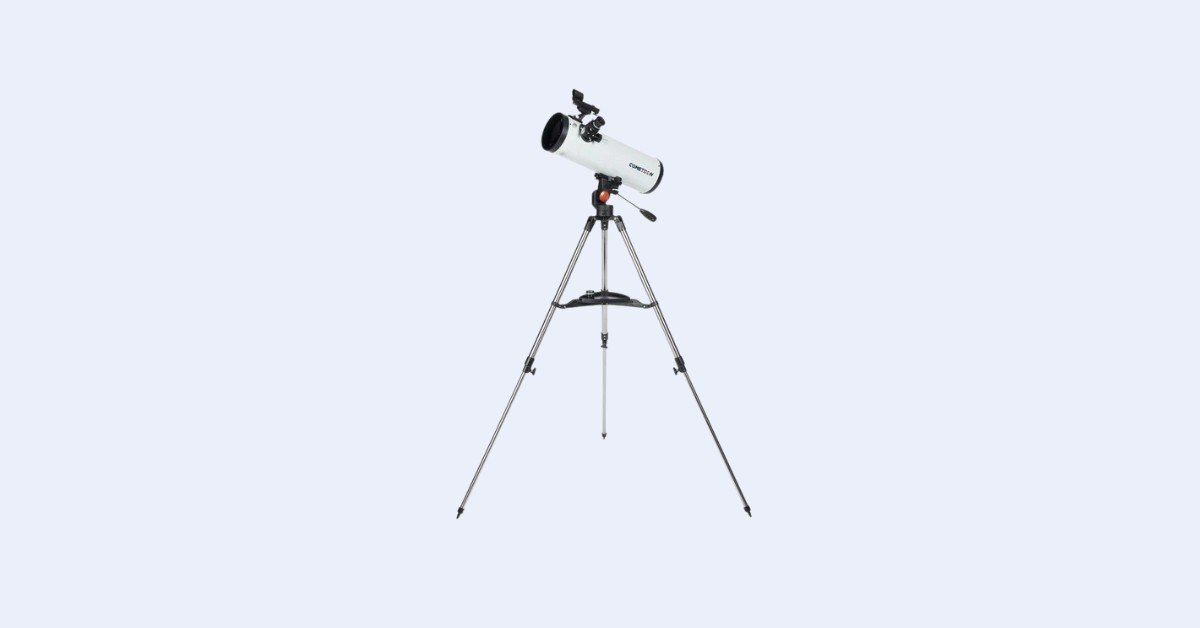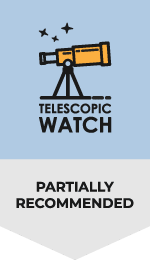The Optical Tube
The Celestron Cometron 114AZ is a 114mm f/3.9 Newtonian reflector with a focal length of 450mm. This telescope has a parabolic primary mirror of excellent quality, allowing it to provide sharp images of celestial objects—in sharp contrast to a spherical mirror, which provides fuzzy images. Unfortunately, at f/3.9, there is a fair amount of coma present, but this only affects the widest field of view and lowest magnifications; you’ll also notice edge-of-field aberrations with the stock low-power 20mm eyepiece, but it’s not much to worry about. You will easily forget about the less-than-sharp stars at the outer perimeter of the field of view.
Collimation at f/3.9 is critical for achieving sharp images, but I find the Cometron 114AZ easy to collimate, with the primary mirror requiring no tools for adjustment; the rarely-adjusted secondary mirror will need a hex key.
To hold your eyepieces, the Cometron 114AZ features a 1.25” rack-and-pinion focuser, mostly made of plastic, which works well but may have some play/wobble when focusing. The tube is secured to the mount with a Vixen-style dovetail, which allows you to interchange it on any astronomical mount or tripod you wish in addition to the provided unit.
Accessories
The Cometron 114AZ reflector telescope includes two 1.25” eyepieces: a 20mm Konig (labeled a Kellner but of a different design) for 23x and a 10mm Kellner for 45x. The 20mm Konig is comfortable to look through and offers a roughly 55-degree apparent field of view, which converts to a 2.4-degree true field with the 450mm focal length of the 114AZ. This is a huge area of sky, and the majority of it will be fairly sharp, though towards the edges of the field of view, the 20mm Konig will display some edge-of-field astigmatism as well as the coma inherent in an f/3.9 reflector.
The 10mm Kellner provided with the Cometron 114AZ is inferior to a Plossl or the 10mm Konig/reverse Kellner design often provided with Celestron telescopes, but it is sharp enough to provide decent images across its 50-degree apparent field.
The battery-powered red dot finder provided with the Cometron 114AZ is easy to use and makes for more than an adequate solution thanks to the huge field of view the scope itself achieves with low magnification. Unfortunately, there are no collimation tools included with the Cometron 114AZ despite the urgent need for one at f/3.9, so users will need to invest in one or make their own out of a film canister. Our collimation guide is an excellent resource to help with the process.
Tripod
The Celestron Cometron 114AZ reflector telescope comes with an alt-azimuth mount and tripod, which are essentially identical to the mount used for the Celestron AstroMaster AZ line of telescopes, and has a universal Vixen-style dovetail saddle for holding the optical tube. The alt-azimuth design of the mount allows for smooth motion in both directions, and the simple clutches can lock or tighten motion. However, due to the optical tube of the telescope riding above the center of the altitude axis on the mount, much like a camera does on a photo tripod, it is always unbalanced when aimed above the horizon. This makes it difficult to use the telescope at high magnifications, especially when pointed near the zenith. Additionally, there are no fine adjustment controls on the mount, which further hinders smooth movement.
The low magnifications you will typically find yourself using the Cometron 114AZ at, combined with its short tube, lessen the impact of the mount’s problems somewhat. As such, one can certainly use the Cometron 114AZ’s provided mount and tripod and have an enjoyable experience, but it would be better if it had a proper astronomical alt-azimuth mount with fine adjustment knobs for tracking adjustments in addition to a properly balanced design with the tube riding next to the altitude axis instead of above it.
Should I buy a Used Celestron Cometron 114AZ?
Despite the Celestron Cometron 114AZ’s mount being at least acceptable, we still suggest you opt for a different telescope, whether you’re buying new or used. Remounting it is likely to cost more than buying a telescope with a better mount, such as the Zhumell Z114, Orion StarBlast 4.5 Astro, or another Dobsonian telescope. When buying any used telescope, such as the Cometron 114AZ, make sure to check for missing accessories, damage or corrosion on the primary mirror, and cracks in any plastic components. These can make the telescope completely worthless to repair compared to purchasing a new unit.
Alternative Recommendations
The Celestron Cometron 114AZ isn’t our first choice in its price range due to the issues we’ve described with its tripod. Various equal or slightly larger Dobsonian telescopes are available at or a little above its price range; tripod-mounted telescopes under $400-$500 or so have design concessions that we would generally recommend you steer clear of if possible.
Under $300
- The Zhumell Z100/Orion SkyScanner 100 aren’t as big as the Cometron 114AZ, but offer equally sharp optics, decent accessories, and an ultra-compact as well as easy-to-use tabletop Dobsonian mount.
- The Zhumell Z114/Orion StarBlast 4.5 Astro, as previously mentioned, feature identical optical tube assemblies and similar accessories to the Cometron 114AZ but have a tabletop Dobsonian mount which provides a sturdier and easier to aim platform for the scopes’ high-quality optics.
- The Sky-Watcher Heritage 130P offers more aperture than the Cometron 114AZ and other 4.5” reflectors, and features a collapsible tube for better portability. The f/5 focal ratio makes the scope a little less stringent when it comes to collimation, too.
$300-$500
- The Sky-Watcher Heritage 150P blows away the views through a smaller 114mm or 130mm reflector but remains portable thanks to its tabletop Dobsonian mount and collapsible tube.
- The Sky-Watcher Virtuoso GTi 150P is identical to the Heritage 150P but adds motorized tracking and GoTo, which are easily set up and controlled by your smartphone. The scope’s FreedomFind encoders allow manual aiming even when the GoTo system is activated, too. The Virtuoso GTi 130P is identical but uses the Heritage 130P optical tube in lieu of the 150P’s.
- The Orion SkyQuest XT6 Classic is a lot less portable than the tabletop reflectors we’ve listed here but stands on its own without a tripod, table, or other supports; it features high-quality optics and a 2” Crayford focuser too.
Aftermarket Accessory Recommendations
While the provided 20mm Konig does not provide the widest field possible for a 1.25” eyepiece, using a lower magnification ocular with the Cometron 114AZ will either produce too large of an exit pupil to be useful and/or not be sufficiently sharp for the additional field of view size to be of benefit, unless it is a fancy wide-angle ocular that costs nearly as much as the 114AZ itself. However, at the other end, 45x is hardly pushing the resolving limits of the 114AZ’s 4.5” aperture; a 6mm “goldline” or “redline” provides 75x, or about the minimum recommended for serious planetary viewing. A 3.2mm eyepiece provides 141x, pushing the limits of the Cometron 114AZ’s mount and ideal for most planetary viewing, while a 2.5mm eyepiece (180x) is about as high as you can realistically expect to be useful due to the limitations of both the telescope and mount.
A UHC nebula filter, such as the Orion UltraBlock, screws onto your 1.25” eyepieces and enhances contrast on nebulae—ideal for a wide-field scope meant for deep-sky viewing like the Cometron. You’ll also need a collimation tool of some kind since the 114AZ is not provided with one; our preference would be a Cheshire or collimation cap design due to the play inherent in the scope’s focuser, which can throw off the accuracy of a laser.
What can you see with Celestron Cometron 114AZ?
Thanks to its wide field of view, the Celestron Cometron 114AZ is a great instrument for low-power viewing of deep-sky objects, and you’ll have no trouble finding many of them even as a beginner. With it, you can easily spot dozens of open clusters, and the brightest emission nebulae such as Orion (M42), the Lagoon (M8), and the Swan (M17), even from the suburbs. Dark skies and a UHC filter bring out large nebulae such as the Rosette Nebula, the Veil supernova remnant, and the North America Nebula. Galaxies require dark skies to appear as much more than fuzzy smudges or even at all; under almost any conditions, you can see the Andromeda Galaxy (M31) easily and a handful of others. Using the Cometron 114AZ under dark skies will allow it to bring out Andromeda’s orbiting companions and dust lanes, along with various galaxy groups like the Virgo Cluster, and features such as dust lanes or hints of spiral structure in other bright galaxies like M33, M82, and M64.
Globular star clusters and planetary nebulae, while beyond the Cometron 114AZ’s ability to resolve clearly due to its small aperture, can still be seen as fuzzy dots. On a good night, there are also thousands of double stars that can be observed with the Cometron 114AZ at high magnification.
The Cometron 114AZ’s optics offer crisp views of the Moon and planets. You can easily spot the phases of Venus and Mercury, as well as the breathtaking detail of ridges, craters, and mountains on the Moon. When Mars is at opposition, a few dark markings may be visible, and the planet’s polar ice cap is obvious most of the time. Jupiter’s cloud belts, along with various atmospheric features like the Great Red Spot, can be seen with the Cometron 114AZ, and high magnifications will allow you to resolve the disks and shadows of the four Galilean moons on a crisp night when they transit in front of Jupiter. You can of course see Saturn’s rings, along with the Cassini Division in them on a steady night. With the 114AZ, you should also be able to make out a few of its moons and some cloud bands on the planet itself. However, with a telescope of this aperture, Uranus and Neptune can be difficult to locate or identify, appearing as mere dots without any visible moons, and Pluto requires a much larger instrument to be seen at all.



